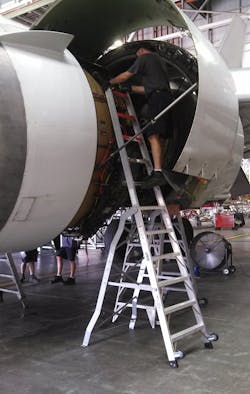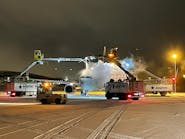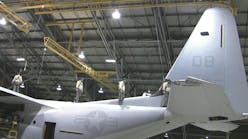How to Reduce Workplace Accidents and Financial Losses
According to the U.S. Consumer Product Safety Commission, in 2014 more than 500,000 ladder-related injuries required medical treatment. Some were minor such as cuts, bruises, and fractured bones, while more serious injuries included broken backs, concussions, and even death. The Centers for Disease Control report that each year nearly 300 people die from ladder-related injuries, and that “the estimated annual cost of ladder injuries in the U.S. is $11 billion, including work loss, medical, legal, liability, and pain and suffering expenses.” Among workers who missed work due to occupational ladder accidents, the average case involved lost time of 11 days. Almost one-third of those cases involved missing 31 or more days of work.
Many experts agree that most accidents and injuries in MRO facilities are related to human conditions such as fatigue, complacency, and stress. These conditions impact both the safety of the maintenance personal and the lives of airline passengers and crew should a mishap occur during flight. Financial costs can be considerable, from aircraft damage to personnel injuries to loss of life. Thus, it is imperative that aviation maintenance technicians not only receive proper safety training, but that equipment used on the job has been designed to minimize risks. And, one of the easiest and most cost-effective items to change is the ladder.
LADDER DESIGN AND LOAD CAPACITY
The Occupational Safety and Health Administration (OSHA) and the American National Standards Institute (ANSI) have promulgated specific guidelines regarding ladder design and load capacity, which have been readily accepted by the Federal Aviation Administration (FAA). Ladders which meet these standards are allowed in the MRO workplace. Ladders are used by MRO technicians every day to access maintenance and repair points on the exterior and interior of the aircraft as well as in the engine shop. Efficient flight line and hangar maintenance decreases downtime and returns the aircraft to service more quickly. Selecting the right ladder promotes safety and facilitates this paradigm, while struggling with an outdated cumbersome ladder retards progress and makes the work unnecessarily difficult.
NOT ALL LADDERS ARE THE SAME
However, not all these approved ladders are equal when considering ancillary features such as ease of movement, comfort when standing, and the ability of the technician to work safely. Potential for mistakes due to the human factors of fatigue and stress can be exacerbated by using the wrong type of ladder to accomplish a particular work assignment, such as an A-frame ladder.
Among human factors responsible for accidents or injuries, stress and fatigue are the most prevalent. These can result from meeting tight deadlines, environmental impediments such as noise, lighting, or temperature, and uncomfortable or awkward working positions. Using a ladder which helps minimize these potentially dangerous effects is tantamount to preventing costly accidents and injuries. It is important to select the right ladder manufacturer whose products have been designed and field tested by the people who use them daily – aviation maintenance technicians.
There are companies that design and build ergonomic safety ladders to meet the specific demands of MRO technicians. One such company, LockNClimb LLC, is headquartered in Independence, KS. “Our ladders are designed by mechanics for use by mechanics,” says LockNClimb’s President and CEO, Jeffrey A. Green, who spends most of the year flying across America to meet with MRO service personnel and safety directors at major commercial airlines, on U.S. military aviation bases, and corporate jet maintenance facilities. “Airlines will call us when they have a problem, usually after a ladder fall incident or back injury,” says Green. “It is surprising with all the modern technology and safety practices in aviation today that some sites are still using ladder designs that are decades old. Our mission is to incorporate scientific ergonomic designs into ladders MRO technicians want to use because they enable them to do their work easier, faster, better, and safer.”
Three unique features aviation maintenance technicians find most advantageous are the detachable tool trays, the extra wide comfort treads, and the wheels which allow the lightweight ergonomic ladders to be easily rolled into position in the hangar or on the flight line.
LADDERS FOR ALL SEGMENTS
The LockNClimb product line contains USA-built packages to service virtually every aircraft in service today, including: Boeing 717, 737, 757, 767, 777, and 787; Airbus 318, 320, and 330; MD-80, 88, and 90; all Embraer jets; all Gulfstream, Hawker, and other corporate jets; all U.S. Army rotorcraft, including the Sikorsky UH-60 Blackhawk, the Boeing CH-47 Chinook, and AH-64 Apache; the Air Force C-130 gunship and KC-135 transport plane; as well as single ladders for use at fixed based operations for private aircraft. LockNClimb’s patented ergonomic safety ladders constructed of industrial quality 6061-grade aluminum, have been laboratory tested and engineer certified as ANSI 14.2, 300-pound, 1A extra heavy-duty ladders, and meet or exceed OSHA specifications.
In corporate jet MRO facilities, floor space can be limited and lightweight, easy-to-move ladders with a small footprint are desired over heavy cumbersome ladders and lifts. Chad Doehring of Duncan Aviation in Lincoln, NE, says, “These ladders conform to the aircraft easily, they allow access to areas we couldn’t get to with a normal ladder. They roll easily, fold for storage, and are incredibly sturdy. Our technicians like them as they don’t require wearing a cumbersome harness when climbing. They promote safety, facilitate the quality of work, and improve morale.”
Military aviation maintenance technicians in the U.S. Army and Air Force also like the way ergonomic safety ladders are designed to fit the aircraft profiles, allowing close working access without damaging sensitive aircraft parts or surfaces. “We have made many trips to test and re-design our ladders to fit military helicopters,” says Green. “And, have added special features required by military regulations such as yellow side rails at the top of the ladders.”
Using the new breed of ergonomic safety ladders and following proper safety procedures in the workplace, will go a long way toward reducing accidents, injuries, and costly claims to both the aviation maintenance technicians and the aircraft company. For more information visit www.locknclimb.com.
Sidebar:
Ten-Point Ladder Safety Checklist:
- Thoroughly inspect any new ladder that has not been previously used to make sure no damage has occurred during shipping.
- Select the correct ladder designed to fit properly in the working area to allow closed working access to the aircraft maintenance or repair area.
- Inspect the ladder for any damage that may have occurred from previous use. If you find damage, do not attempt repairs, tag the ladder and remove it from service.
- Roll your ladder to the working area while maintaining vigilance not to hit any equipment en route. Tilt the ladder up, walk or slide it into position so it rests securely on the brass or rubber feet.
- Before climbing, make sure the folding brackets are fully deployed. Look for any grease or oil on the floor or on your shoes which may cause the ladder to slip. Mark oil spill hazards and report to supervisor.
- Double check the safety sticker on the side of the ladder to make sure it is rated to safely handle your body weight and the weight of tools or parts you will be carrying.
- When ascending the ladder maintain secure “three-point contact” at all times. That is, two hands and one foot should alternate with two feet and one hand at all times when climbing.
- As you reach your desired working height, make sure not to stand above the second step from the top marked with the “Do Not Stand” safety sticker.
- When working, be sure to face your work without twisting your spine, staying “within the rails.” If you have to reach too far, descend and reposition the ladder. Always lay the ladder down on the surface when not using.
- After work, descend the ladder maintaining the same three-point contact. Be careful not to drop the ladder as it may cause damage that will render the ladder unusable. Return ladder to staging area, and inspect one more time to make certain no damage has occurred during use.




